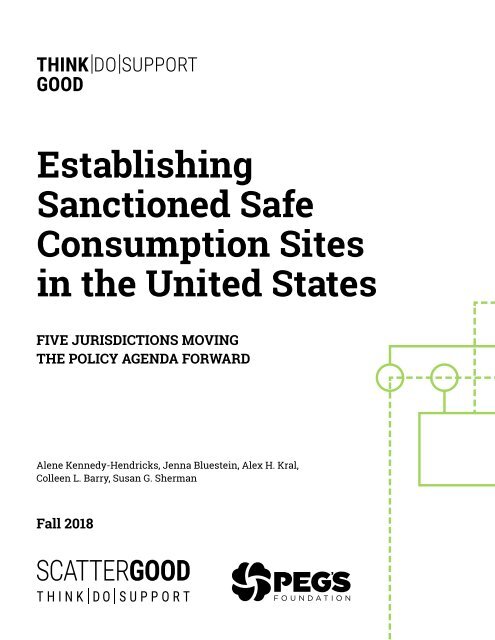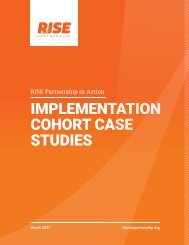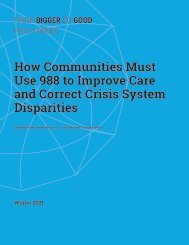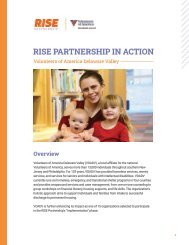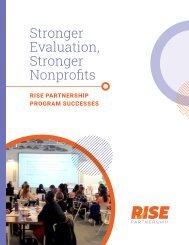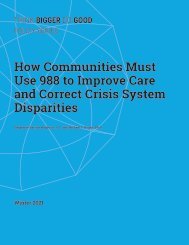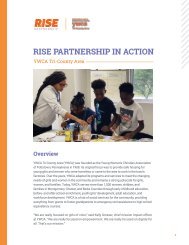Scattergood_Establishing Sanctioned Safe Consumption Sites in the United States_Web
You also want an ePaper? Increase the reach of your titles
YUMPU automatically turns print PDFs into web optimized ePapers that Google loves.
<strong>Establish<strong>in</strong>g</strong><br />
<strong>Sanctioned</strong> <strong>Safe</strong><br />
<strong>Consumption</strong> <strong>Sites</strong><br />
<strong>in</strong> <strong>the</strong> <strong>United</strong> <strong>States</strong><br />
FIVE JURISDICTIONS MOVING<br />
THE POLICY AGENDA FORWARD<br />
Alene Kennedy-Hendricks, Jenna Blueste<strong>in</strong>, Alex H. Kral,<br />
Colleen L. Barry, Susan G. Sherman<br />
Fall 2018
Behavioral Health and <strong>the</strong> Individual Health Insurance Market
Dear Reader,<br />
We are <strong>in</strong> <strong>the</strong> midst of <strong>the</strong> worst epidemic <strong>in</strong> generations and we cont<strong>in</strong>ue to lose ground <strong>in</strong> terms of<br />
<strong>the</strong> annual number of people who overdose and die from opioids. There is an ever-grow<strong>in</strong>g sale of <strong>the</strong>se<br />
substances, legal and illegal. Every day <strong>in</strong> <strong>the</strong> <strong>United</strong> <strong>States</strong> an estimated 142 people die from drug overdoses,<br />
and such deaths are surely underreported. Deaths from opioid overdoses have cont<strong>in</strong>ued to rise,<br />
attributable to <strong>the</strong> <strong>in</strong>creased use of hero<strong>in</strong> and fentanyl additives, with estimates of an <strong>in</strong>crease of 22%<br />
<strong>in</strong> 2016. The recent rise <strong>in</strong> fentanyl-related overdose deaths suggests that new approaches are necessary<br />
to combat <strong>the</strong> opioid epidemic, <strong>in</strong>clud<strong>in</strong>g adoption of harm reduction strategies.<br />
In recent years, major U.S. policy efforts have been aimed at combat<strong>in</strong>g <strong>the</strong> epidemic of opioid addiction<br />
and overdose deaths. In response to <strong>the</strong> epidemic, <strong>the</strong> medical community and policymakers at<br />
<strong>the</strong> federal, state, and local levels have <strong>in</strong>tervened by us<strong>in</strong>g various approaches, <strong>in</strong>clud<strong>in</strong>g: <strong>the</strong> release<br />
of new cl<strong>in</strong>ical guidel<strong>in</strong>es on opioid prescrib<strong>in</strong>g and regulations on opioid dos<strong>in</strong>g; establishment of and<br />
regulations regard<strong>in</strong>g use of prescription drug-monitor<strong>in</strong>g programs; pill-mill crackdowns and enforcement<br />
efforts; <strong>in</strong>surance changes to broaden access to evidence-based addiction treatment; and regulatory<br />
changes to expand <strong>the</strong> supply of physicians tra<strong>in</strong>ed <strong>in</strong> addiction medic<strong>in</strong>e; and o<strong>the</strong>r approaches.<br />
However, <strong>the</strong>y have done little to reverse <strong>the</strong> <strong>in</strong>crease <strong>in</strong> mortality related to opioid overdose.<br />
Now is <strong>the</strong> time to change public policies, service delivery and fund<strong>in</strong>g mechanisms to solve for this<br />
epidemic. This white paper focuses specifically on <strong>the</strong> sanctioned safe consumption sites as part of a<br />
broader harm reduction strategy. Currently no safe consumption site exists <strong>in</strong> <strong>the</strong> <strong>United</strong> <strong>States</strong> and<br />
<strong>the</strong>re are few studies which have explored <strong>the</strong> processes facilitat<strong>in</strong>g policy adoption of sanctioned safe<br />
consumption sites. This paper fur<strong>the</strong>r exam<strong>in</strong>es <strong>the</strong> grow<strong>in</strong>g movement to establish sanctioned safe<br />
consumption sites across five cities <strong>in</strong> <strong>the</strong> <strong>United</strong> <strong>States</strong>, with recommendations for <strong>the</strong> jurisdictions<br />
contemplat<strong>in</strong>g open<strong>in</strong>g a safe consumption site.<br />
We hope you use this paper to extend progress of <strong>the</strong> safe consumptions sites and avoid los<strong>in</strong>g ground<br />
at a time of great need.<br />
S<strong>in</strong>cerely,<br />
Joseph Pyle, M.A.<br />
President<br />
Thomas <strong>Scattergood</strong> Behavioral<br />
Health Foundation<br />
Rick Kellar, M.B.A.<br />
President<br />
Peg’s Foundation
Titles <strong>in</strong> <strong>the</strong> Paper Series<br />
Editors Howard Goldman, M.D., Ph.D. and Constance Gartner, M.S.W.<br />
America’s Opioid Epidemic Lloyd Sederer, M.D.<br />
Fentanyl and <strong>the</strong> Evolv<strong>in</strong>g Opioid Epidemic: What Strategies Should Policymakers<br />
Consider? Colleen Barry, Ph.D., M.P.P.<br />
<strong>Establish<strong>in</strong>g</strong> <strong>Sanctioned</strong> <strong>Safe</strong> <strong>Consumption</strong> <strong>Sites</strong> <strong>in</strong> <strong>the</strong> <strong>United</strong> <strong>States</strong>: Five Jurisdictions Mov<strong>in</strong>g <strong>the</strong> Policy Agenda Forward 4
<strong>Establish<strong>in</strong>g</strong><br />
<strong>Sanctioned</strong> <strong>Safe</strong><br />
<strong>Consumption</strong> <strong>Sites</strong><br />
<strong>in</strong> <strong>the</strong> <strong>United</strong> <strong>States</strong><br />
FIVE JURISDICTIONS MOVING<br />
THE POLICY AGENDA FORWARD<br />
Alene Kennedy-Hendricks, Ph.D.<br />
Department of Health Policy and Management<br />
Center for Mental Health and Addiction Policy Research<br />
Johns Hopk<strong>in</strong>s Bloomberg School of Public Health<br />
Colleen L. Barry, Ph.D., M.P.P.<br />
Department of Health Policy and Management<br />
Center for Mental Health and Addiction Policy Research<br />
Johns Hopk<strong>in</strong>s Bloomberg School of Public Health<br />
Jenna Blueste<strong>in</strong>, B.A.<br />
Department of Health Policy and Management<br />
Center for Mental Health and Addiction Policy Research<br />
Johns Hopk<strong>in</strong>s Bloomberg School of Public Health<br />
Susan G. Sherman, Ph.D., M.P.H.<br />
Department of Health Behavior and Society<br />
Center for Mental Health and Addiction Policy Research<br />
Johns Hopk<strong>in</strong>s Bloomberg School of Public Health<br />
Alex H. Kral, Ph.D.<br />
Behavioral Health and Crim<strong>in</strong>al Justice Division<br />
RTI International<br />
Fall 2018
Introduction<br />
The <strong>United</strong> <strong>States</strong> is fac<strong>in</strong>g a susta<strong>in</strong>ed addiction and overdose epidemic that is<br />
historic <strong>in</strong> its magnitude, pervasiveness, and geographic reach. The provisional<br />
count of drug overdose deaths <strong>in</strong> 2017 surpasses 70,000. 1 Reversals <strong>in</strong> life expectancy<br />
ga<strong>in</strong>s <strong>in</strong> <strong>the</strong> U.S. have been attributed <strong>in</strong> part to ris<strong>in</strong>g drug overdose mortality rates. 2<br />
Illicitly manufactured fentanyl, a syn<strong>the</strong>tic opioid significantly stronger than hero<strong>in</strong>,<br />
has become <strong>in</strong>creas<strong>in</strong>gly prevalent, escalat<strong>in</strong>g <strong>the</strong> lethal risk of drug consumption. 3,4<br />
In addition to overdose mortality, <strong>in</strong>creas<strong>in</strong>g <strong>in</strong>cidence of hepatitis C virus 5 and<br />
recent localized HIV outbreaks have been traced to <strong>in</strong>jection drug use. 6 The federal<br />
government and a number of states have declared <strong>the</strong> opioid epidemic a public<br />
health emergency. 7,8<br />
Despite implementation of numerous policies to curtail <strong>the</strong> drug epidemic, trends <strong>in</strong><br />
addiction and overdose deaths are escalat<strong>in</strong>g. It is <strong>in</strong> this context that jurisdictions<br />
are search<strong>in</strong>g for new policy solutions. One proposed approach <strong>in</strong>volves establish<strong>in</strong>g<br />
safe consumption sites (SCSs), also known as supervised <strong>in</strong>jection facilities and<br />
overdose prevention sites, among o<strong>the</strong>r names. SCSs are places where people can<br />
use pre-obta<strong>in</strong>ed drugs <strong>in</strong> a hygienic sett<strong>in</strong>g with supervision by tra<strong>in</strong>ed staff and<br />
connect to o<strong>the</strong>r health and social services. 9 More than 100 sanctioned SCSs exist <strong>in</strong><br />
66 cities <strong>in</strong> Canada, Australia, and Europe.9<br />
Evaluations of InSite, <strong>the</strong> first North American facility, which opened <strong>in</strong> 2003 <strong>in</strong><br />
Vancouver, Canada, suggest that an SCS can produce important benefits for people<br />
who use drugs, <strong>in</strong>clud<strong>in</strong>g reduc<strong>in</strong>g fatal overdoses, 10,11 <strong>in</strong>creas<strong>in</strong>g connection to<br />
addiction treatment, 12,13 and facilitat<strong>in</strong>g safer <strong>in</strong>jection practices and less syr<strong>in</strong>ge<br />
shar<strong>in</strong>g. 14,15 Research on <strong>the</strong> broader community impacts of InSite <strong>in</strong>dicates<br />
reductions <strong>in</strong> public drug use and syr<strong>in</strong>ge debris, 16 with no <strong>in</strong>crease <strong>in</strong> drug-related<br />
crime <strong>in</strong> <strong>the</strong> neighborhood. 17 Systematic reviews of research conducted <strong>in</strong> a wider<br />
range of geographic sett<strong>in</strong>gs also have found SCSs to be associated with positive<br />
outcomes both for <strong>the</strong> people us<strong>in</strong>g <strong>the</strong>se facilities and for <strong>the</strong> broader communities<br />
<strong>in</strong> which <strong>the</strong>y are located. 18,19 Recent cost-benefit analyses <strong>in</strong> San Francisco and<br />
Baltimore have estimated that SCS implementation would generate cost sav<strong>in</strong>gs by<br />
reduc<strong>in</strong>g spend<strong>in</strong>g on <strong>the</strong> medical complications of unsafe drug consumption. 20,21<br />
<strong>Establish<strong>in</strong>g</strong> <strong>Sanctioned</strong> <strong>Safe</strong> <strong>Consumption</strong> <strong>Sites</strong> <strong>in</strong> <strong>the</strong> <strong>United</strong> <strong>States</strong>: Five Jurisdictions Mov<strong>in</strong>g <strong>the</strong> Policy Agenda Forward 6
To date, no sanctioned SCS exists <strong>in</strong> <strong>the</strong> <strong>United</strong> <strong>States</strong>. One underground site has<br />
been operat<strong>in</strong>g s<strong>in</strong>ce 20149, 22 and some syr<strong>in</strong>ge services providers manage quasi-<br />
SCSs <strong>in</strong> bathrooms that push <strong>the</strong> boundaries of legal sanction. 23 At <strong>the</strong> time of this<br />
writ<strong>in</strong>g, legislation to establish SCSs has been <strong>in</strong>troduced <strong>in</strong> at least six states (CA,<br />
NY, MD, CO, VT, and MA), with vary<strong>in</strong>g degrees of success. In 2017, <strong>the</strong> California<br />
State Assembly passed a bill to establish SCSs, and <strong>the</strong> State Senate passed <strong>the</strong> bill<br />
<strong>in</strong> 2018. 24 On <strong>the</strong> local level, <strong>the</strong> Seattle City Council allocated fund<strong>in</strong>g for operat<strong>in</strong>g<br />
SCSs, 25 although <strong>the</strong> city has not yet opened a site.<br />
Few studies have explored <strong>the</strong> processes facilitat<strong>in</strong>g policy adoption of SCSs, 26–28 and<br />
no research of which we are aware has exam<strong>in</strong>ed <strong>the</strong> grow<strong>in</strong>g movement to establish<br />
SCSs <strong>in</strong> <strong>the</strong> <strong>United</strong> <strong>States</strong>. Through <strong>in</strong>terviews with key <strong>in</strong>formants <strong>in</strong> five locations<br />
across <strong>the</strong> U.S., we (1) describe <strong>the</strong> local context related to drug use and overdose that<br />
SCSs might help to address, (2) characterize <strong>the</strong> organiz<strong>in</strong>g strategies that advocates<br />
have employed to build momentum around SCSs, (3) consider <strong>the</strong> challenges to SCS<br />
adoption, and (4) identify factors that have facilitated progress toward SCS adoption.<br />
On <strong>the</strong> basis of <strong>the</strong>se f<strong>in</strong>d<strong>in</strong>gs, we propose a set of recommendations for o<strong>the</strong>r<br />
communities to consider <strong>in</strong> <strong>the</strong> context of discussions about establish<strong>in</strong>g SCSs.
METHODS<br />
Data Collection<br />
Although movements to establish SCSs are grow<strong>in</strong>g around <strong>the</strong> country, we<br />
narrowed our focus to five locations <strong>in</strong> which advocates have secured support<br />
from key elected officials or have made measurable progress <strong>in</strong> advanc<strong>in</strong>g policy<br />
to establish sanctioned SCSs (e.g., advanc<strong>in</strong>g state legislation out of committee).<br />
We identified an <strong>in</strong>itial set of study participants through <strong>the</strong> networks of two study<br />
authors (AHK and SGS) with ties to <strong>the</strong> harm reduction community and <strong>the</strong>n used<br />
snowball sampl<strong>in</strong>g to recruit additional participants with<strong>in</strong> each jurisdiction. To<br />
ma<strong>in</strong>ta<strong>in</strong> <strong>the</strong> confidentiality of participants, we do not identify <strong>the</strong> five locations <strong>in</strong><br />
our sample.<br />
Between late April and early July 2018, we conducted 25 <strong>in</strong>terviews with a purposive<br />
sample of four to six key <strong>in</strong>formants from each location. Participants <strong>in</strong>cluded<br />
members of <strong>the</strong> organiz<strong>in</strong>g and advocacy community, local government officials,<br />
and personnel with social service and health organizations, <strong>in</strong>clud<strong>in</strong>g organizations<br />
consider<strong>in</strong>g operat<strong>in</strong>g an SCS <strong>in</strong> <strong>the</strong> future. Interviews took place by telephone and<br />
ranged from 45 m<strong>in</strong>utes to one hour. The study team drew on <strong>the</strong> literature and team<br />
member expertise on this topic to develop a semi-structured <strong>in</strong>terview guide. One<br />
study team member took detailed notes dur<strong>in</strong>g each <strong>in</strong>terview. The Johns Hopk<strong>in</strong>s<br />
Bloomberg School of Public Health Institutional Review Board designated <strong>the</strong> study<br />
not human subjects research.<br />
<strong>Establish<strong>in</strong>g</strong> <strong>Sanctioned</strong> <strong>Safe</strong> <strong>Consumption</strong> <strong>Sites</strong> <strong>in</strong> <strong>the</strong> <strong>United</strong> <strong>States</strong>: Five Jurisdictions Mov<strong>in</strong>g <strong>the</strong> Policy Agenda Forward 8
Analysis<br />
Analysis of <strong>in</strong>terview notes employed a hybrid <strong>in</strong>ductive-deductive cod<strong>in</strong>g process.<br />
All study team members reviewed <strong>the</strong> <strong>in</strong>terview notes, identify<strong>in</strong>g important<br />
<strong>the</strong>mes. One study member (AK-H) <strong>the</strong>n systematically analyzed <strong>the</strong> data us<strong>in</strong>g<br />
NVivo 12 Pro qualitative analysis software. 29 Segments of <strong>the</strong> text were <strong>in</strong>itially coded<br />
for <strong>the</strong> a priori <strong>the</strong>mes identified dur<strong>in</strong>g <strong>the</strong> group review of <strong>in</strong>terview notes and<br />
<strong>the</strong>n coded iteratively to capture new <strong>the</strong>mes emerg<strong>in</strong>g dur<strong>in</strong>g <strong>the</strong> cod<strong>in</strong>g process.<br />
Related text segments were <strong>the</strong>n categorized <strong>in</strong>to overarch<strong>in</strong>g <strong>the</strong>mes.
Results<br />
Across <strong>the</strong> five locations, much of <strong>the</strong> effort to establish SCSs<br />
was concentrated <strong>in</strong> urban sett<strong>in</strong>gs. Participants represented<br />
<strong>the</strong> organiz<strong>in</strong>g and advocacy community; social service and<br />
health providers, <strong>in</strong>clud<strong>in</strong>g syr<strong>in</strong>ge services programs; and<br />
local government.<br />
Def<strong>in</strong><strong>in</strong>g <strong>the</strong> Problem that SCSs Address<br />
Study participants identified SCS implementation as a policy<br />
response to <strong>the</strong> follow<strong>in</strong>g social problems: (1) overdose deaths,<br />
(2) economic development–<strong>in</strong>duced displacement and<br />
homelessness, and (3) publicly visible drug use and syr<strong>in</strong>ge<br />
debris. Many participants identified all three problems as<br />
driv<strong>in</strong>g <strong>in</strong>terest <strong>in</strong> SCSs. However, <strong>the</strong> salience of <strong>the</strong>se<br />
problems varied by geographic region. Participants suggested<br />
that ris<strong>in</strong>g overdose death rates were play<strong>in</strong>g a greater role<br />
<strong>in</strong> driv<strong>in</strong>g policy discussions around SCSs <strong>in</strong> parts of <strong>the</strong> U.S.<br />
where overdose mortality rates are ris<strong>in</strong>g rapidly. However,<br />
even <strong>in</strong> areas of <strong>the</strong> country where drug overdose death<br />
rates have risen more slowly, <strong>the</strong>re was a sense that <strong>the</strong><br />
broader national narrative about <strong>the</strong> overdose epidemic has<br />
contributed to a greater will<strong>in</strong>gness to consider SCS policy.<br />
In several locations, participants noted that <strong>in</strong>terest <strong>in</strong><br />
SCSs appeared to be driven more by concern about public<br />
drug use and syr<strong>in</strong>ge debris than <strong>the</strong> well-be<strong>in</strong>g of people<br />
who use drugs. Participants viewed <strong>the</strong> issues of economic<br />
development and displacement, homelessness, visible drug<br />
use, and syr<strong>in</strong>ge debris as <strong>in</strong>ter-related. In cities experienc<strong>in</strong>g<br />
rapid gentrification, people who previously used drugs <strong>in</strong><br />
more hidden sett<strong>in</strong>gs (e.g., low-cost hous<strong>in</strong>g and abandoned<br />
build<strong>in</strong>gs) were now us<strong>in</strong>g <strong>in</strong> <strong>the</strong> streets or <strong>in</strong> public<br />
bathrooms. In some cities, people who use drugs congregate <strong>in</strong><br />
visible encampments, <strong>in</strong>clud<strong>in</strong>g tents. Participants expressed<br />
that SCSs were a critical but <strong>in</strong>complete policy response to <strong>the</strong><br />
issues affect<strong>in</strong>g people who use drugs and <strong>the</strong> neighborhoods<br />
<strong>in</strong> which <strong>the</strong>y live.<br />
Gett<strong>in</strong>g SCS on <strong>the</strong> Policy Agenda<br />
Four of <strong>the</strong> five locations had established governmentsponsored<br />
committees that formally recommended SCS<br />
adoption. Three jurisdictions organized <strong>the</strong>se committees<br />
around a broader topic (e.g., <strong>the</strong> opioid crisis) and <strong>in</strong>cluded<br />
SCS adoption as one of several recommendations. The reports<br />
generated by <strong>the</strong>se committees attracted media attention<br />
to SCSs, raised <strong>the</strong> profile of SCSs among <strong>the</strong> general public,<br />
catalyzed organiz<strong>in</strong>g efforts, and provided political cover for<br />
elected officials to support SCSs.<br />
“In [X state], <strong>the</strong> long game is to get<br />
legislation passed . . . if it passes, it will<br />
be a game changer on this issue for <strong>the</strong><br />
state and <strong>the</strong> country.”<br />
Exhibit 1 highlights strategies beh<strong>in</strong>d target<strong>in</strong>g efforts to<br />
obta<strong>in</strong> legal sanction. Participants <strong>in</strong> <strong>the</strong> two locations that<br />
were focused exclusively on <strong>the</strong> local government reported<br />
that state politics drove this tactical approach, but <strong>the</strong>y also felt<br />
that state-level policy action wasn’t necessary for establish<strong>in</strong>g<br />
SCSs. Among <strong>the</strong> three jurisdictions that had <strong>in</strong>troduced state<br />
legislation to establish SCSs, all were also pursu<strong>in</strong>g o<strong>the</strong>r<br />
mechanisms for achiev<strong>in</strong>g legal sanction, <strong>in</strong>clud<strong>in</strong>g through<br />
<strong>the</strong> authorization of a research pilot, city council ord<strong>in</strong>ance, or<br />
state or local health department action.<br />
<strong>Establish<strong>in</strong>g</strong> <strong>Sanctioned</strong> <strong>Safe</strong> <strong>Consumption</strong> <strong>Sites</strong> <strong>in</strong> <strong>the</strong> <strong>United</strong> <strong>States</strong>: Five Jurisdictions Mov<strong>in</strong>g <strong>the</strong> Policy Agenda Forward 10
Exhibit 1 Level of Government Targeted to Advance SCS Policy<br />
City or<br />
County<br />
Description of Approach<br />
All five jurisdictions were pursu<strong>in</strong>g local<br />
government policy mechanisms to establish<br />
SCSs (e.g., health department approval,<br />
emergency declaration, city ord<strong>in</strong>ance). Two<br />
jurisdictions focused exclusively on policy<br />
mechanisms available at <strong>the</strong> city/county level<br />
because state government level support was not<br />
feasible. Both had executive branch support (i.e.,<br />
mayor, health department). One jurisdiction’s city<br />
council had allocated fund<strong>in</strong>g for an SCS.<br />
Quotations Expla<strong>in</strong><strong>in</strong>g Approach<br />
“We advocated not to do [state legislation] because we knew<br />
that it couldn’t pass <strong>the</strong> legislature because of split control.<br />
. . . [There was] concern that hav<strong>in</strong>g a bill fail can create <strong>the</strong><br />
impression that without that bill, you can’t do it, but that’s<br />
not true. The public health department can do it without <strong>the</strong><br />
bill so we were afraid of detrimental effects from a failed<br />
bill.”<br />
“The mayor could declare a public health emergency. This is<br />
how <strong>the</strong>y established syr<strong>in</strong>ge services. Ano<strong>the</strong>r mechanism<br />
could be an ord<strong>in</strong>ance from <strong>the</strong> city council that would be<br />
renewed <strong>in</strong> perpetuity.”<br />
State<br />
Legislation<br />
Description of Approach<br />
In three of <strong>the</strong> five jurisdictions, state legislators<br />
had <strong>in</strong>troduced bills authoriz<strong>in</strong>g SCSs. None had<br />
passed at <strong>the</strong> time of this study, but sponsors<br />
were plann<strong>in</strong>g to re-<strong>in</strong>troduce bills <strong>in</strong> subsequent<br />
legislative sessions. Participants from <strong>the</strong> two<br />
jurisdictions <strong>in</strong> states that had not <strong>in</strong>troduced<br />
legislation authoriz<strong>in</strong>g SCSs opted not to do so<br />
given <strong>the</strong> political composition of <strong>the</strong>ir state<br />
legislatures.<br />
Quotations Expla<strong>in</strong><strong>in</strong>g Approach<br />
“In [X state], <strong>the</strong> long game is to get legislation passed . . . if it<br />
passes, it will be a game changer on this issue for <strong>the</strong> state<br />
and <strong>the</strong> country.”<br />
“We could have <strong>in</strong>troduced <strong>the</strong> [state] legislative package<br />
and tried to build movement <strong>in</strong> [X city], but I don’t th<strong>in</strong>k<br />
[X city] is conducive to that. . . . [O<strong>the</strong>r cities plann<strong>in</strong>g to<br />
implement SCS] are <strong>the</strong> biggest tax generators <strong>in</strong> <strong>the</strong>ir state.<br />
. . . [X city] can’t do its own th<strong>in</strong>g <strong>in</strong> <strong>the</strong> same way that those<br />
[jurisdictions] can.”<br />
Multiple<br />
pathways<br />
Description of Approach<br />
In <strong>the</strong> three jurisdictions pursu<strong>in</strong>g state<br />
legislation, <strong>the</strong> state legislation was part of a<br />
broader strategy that <strong>in</strong>volved pursu<strong>in</strong>g locallevel<br />
policy change as well. Advocates <strong>in</strong> one<br />
jurisdiction also were work<strong>in</strong>g to push <strong>the</strong> state<br />
executive branch (i.e., governor and state health<br />
department) to authorize SCS adoption as pilot<br />
research.<br />
Quotations Expla<strong>in</strong><strong>in</strong>g Approach<br />
“[T]he legislative push is support<strong>in</strong>g <strong>the</strong> [research] pilot<br />
push. . . . In our m<strong>in</strong>d, of course we want to pass legislation.<br />
The legislation supports <strong>the</strong> pilot efforts and <strong>the</strong> pilot efforts<br />
support <strong>the</strong> legislation.”<br />
“[There is a] whole o<strong>the</strong>r conversation to be had about<br />
<strong>the</strong> state legislation we’re runn<strong>in</strong>g—a state bill to create<br />
authorization for <strong>the</strong> city to create [SCSs] and protect <strong>the</strong> city<br />
from state law.”<br />
Bracketed text <strong>in</strong>dicates edit<strong>in</strong>g by <strong>the</strong> authors ei<strong>the</strong>r to clarify <strong>the</strong> context of <strong>the</strong> quotation or to substitute potentially identify<strong>in</strong>g <strong>in</strong>formation with more generic language.
Organiz<strong>in</strong>g and Coalition Build<strong>in</strong>g<br />
Organiz<strong>in</strong>g efforts were heterogeneous <strong>in</strong> terms of <strong>the</strong> groups lead<strong>in</strong>g <strong>the</strong><br />
movement, <strong>the</strong> extent to which <strong>the</strong> advocates composed an organized coalition,<br />
<strong>the</strong> level of <strong>in</strong>volvement from people who use drugs, and <strong>the</strong> tactics advocates<br />
employed to engage relevant groups and garner political support (see Exhibit 2).<br />
Participants <strong>in</strong> all jurisdictions emphasized <strong>the</strong> importance of engag<strong>in</strong>g those<br />
with diverse perspectives and motivations for support<strong>in</strong>g SCSs. Engag<strong>in</strong>g diverse<br />
voices enabled organizers to build a broader coalition and more successfully lobby<br />
policymakers. Participants emphasized <strong>the</strong> importance of support<strong>in</strong>g or “show<strong>in</strong>g<br />
up” for potential allies as <strong>the</strong>y built a coalition, illum<strong>in</strong>at<strong>in</strong>g both <strong>the</strong> transactional<br />
nature of organiz<strong>in</strong>g and <strong>the</strong> extent to which many allies often shared a wider set of<br />
political goals. Although participants <strong>in</strong> all jurisdictions emphasized <strong>the</strong> importance<br />
of <strong>in</strong>clud<strong>in</strong>g people who use drugs <strong>in</strong> advocacy efforts, <strong>the</strong>re was significant<br />
variation <strong>in</strong> <strong>the</strong> extent to which <strong>the</strong>y had achieved this goal. People who use drugs<br />
were more <strong>in</strong>volved <strong>in</strong> places that had established drug user unions, whereas <strong>in</strong><br />
o<strong>the</strong>r jurisdictions, organiz<strong>in</strong>g around SCSs was driv<strong>in</strong>g <strong>the</strong> organiz<strong>in</strong>g of this group.<br />
Political strategy <strong>in</strong>volved <strong>in</strong>itially target<strong>in</strong>g policymakers who were anticipated to<br />
be receptive to SCSs, educat<strong>in</strong>g policymakers and connect<strong>in</strong>g <strong>the</strong>m to <strong>in</strong>formation,<br />
pressur<strong>in</strong>g key policymakers who resisted publicly support<strong>in</strong>g SCSs, committ<strong>in</strong>g<br />
acts of civil disobedience, and position<strong>in</strong>g SCS adoption as a campaign issue on<br />
which candidates had to comment.<br />
“We used comprehensive syr<strong>in</strong>ge exchange supporters<br />
to target for potential SCS support. It became more<br />
acceptable over time, and we have about 30 cosponsors<br />
on <strong>the</strong> SCS bill now. A lot of members were moved by<br />
targeted advocacy, lobby<strong>in</strong>g, and testimony.”<br />
<strong>Establish<strong>in</strong>g</strong> <strong>Sanctioned</strong> <strong>Safe</strong> <strong>Consumption</strong> <strong>Sites</strong> <strong>in</strong> <strong>the</strong> <strong>United</strong> <strong>States</strong>: Five Jurisdictions Mov<strong>in</strong>g <strong>the</strong> Policy Agenda Forward 12
Exhibit 2 Organiz<strong>in</strong>g and Coalition Build<strong>in</strong>g<br />
Engag<strong>in</strong>g Partners with Diverse Perspectives<br />
“Support is challeng<strong>in</strong>g because it sometimes comes from people who just want <strong>the</strong>se <strong>in</strong>dividuals to disappear, but <strong>the</strong>y are vocal about <strong>the</strong> need<br />
for SCSs because of syr<strong>in</strong>ges on <strong>the</strong> street.”<br />
“Diverse coalition seems very critical . . . geographically diverse across <strong>the</strong> state, and we also mean racially diverse and diverse <strong>in</strong> how you arrive<br />
at this work. [It’s] critical for <strong>the</strong> coalition and for <strong>the</strong> legislators we engage.”<br />
Focus of Organiz<strong>in</strong>g Efforts<br />
“[X location] has a good ground game. . . . They’ve been putt<strong>in</strong>g toge<strong>the</strong>r a concerted grassroots community education and mobilization campaign.<br />
In [ano<strong>the</strong>r location], <strong>the</strong>re isn’t really a ground game and media strategy. . . . There’s more beh<strong>in</strong>d-<strong>the</strong>-scenes meet<strong>in</strong>g to educate legislators and<br />
convene community stakeholders.”<br />
“[X location] is challeng<strong>in</strong>g because <strong>the</strong>re’s an emerg<strong>in</strong>g dynamic of gentrification <strong>in</strong> which a class of highly educated white professionals are<br />
mov<strong>in</strong>g <strong>in</strong> and are seen as ‘new [name of locality]’ and <strong>the</strong>y tend to be easier to conv<strong>in</strong>ce on th<strong>in</strong>gs like [SCSs], but you don’t want <strong>the</strong>m to be <strong>the</strong><br />
face of your grassroots movement.”<br />
Show<strong>in</strong>g Up for Allies<br />
“[W]e built a strong relationship with [local peer recovery group] and [th<strong>in</strong>k about] how we can show up for <strong>the</strong>m and <strong>in</strong>tegrate advocacy more <strong>in</strong>to<br />
<strong>the</strong>ir work, and that’s a long-term process that is an <strong>in</strong>tensive and important piece of this work.”<br />
Description of Approach<br />
“[A new advocacy organization] coalesced around . . . service provision under <strong>the</strong> bridges to build trust . . . with people with lived experience to<br />
build social capital and make sure people know we are not just advocates but service providers. We hoped that <strong>the</strong> [organization] would become<br />
an auxiliary to <strong>the</strong> union of people who use drugs.”<br />
“Our members identify more or less as drug users. But <strong>the</strong> truth is that some are active drug users and some are fully <strong>in</strong> recovery but identify as<br />
drug users for political reasons. . . . For us, what’s most important is: Are you a victim of <strong>the</strong> drug war? We don’t organize ‘Wall Street’ drug users.”<br />
Learn<strong>in</strong>g from Previous Policy Change Efforts<br />
“A lesson learned from LEAD [Law Enforcement Assisted Diversion] was br<strong>in</strong>g<strong>in</strong>g <strong>in</strong> people to build consensus who have different motivations. . .<br />
. It was really clear that <strong>the</strong>re was never go<strong>in</strong>g to be agreement on a wide range of issues, so we focused on a couple th<strong>in</strong>gs we could agree on and<br />
leave disagreements at <strong>the</strong> door.”<br />
Target<strong>in</strong>g Friendly Policymakers First<br />
“[We] focused on solid, traditional allies.”<br />
“We used comprehensive syr<strong>in</strong>ge exchange supporters to target for potential SCS support. It became more acceptable over time, and we have<br />
about 30 cosponsors on <strong>the</strong> SCS bill now. A lot of members were moved by targeted advocacy, lobby<strong>in</strong>g, and testimony.”<br />
“[We are] plann<strong>in</strong>g to meet with city council members, first with folks who are likely to support [SCSs].”<br />
Educat<strong>in</strong>g Policymakers<br />
“We do a lot of education with elected officials, help<strong>in</strong>g <strong>the</strong>m work through questions with constituents.”<br />
“[The current police chief] met with <strong>the</strong> previous chief [<strong>in</strong> Vancouver] about law enforcement impact research from Vancouver, and he was really<br />
enthusiastic because he saw it as a solution to a lot of <strong>the</strong> problems his department is deal<strong>in</strong>g with, namely public syr<strong>in</strong>ges.”<br />
Publicly Pressur<strong>in</strong>g Policymakers<br />
“We took to publicly attack<strong>in</strong>g [key elected official]. We did a number of demonstrations and public confrontations and civil disobedience actions<br />
that got a lot of attention.”<br />
“We’re keep<strong>in</strong>g <strong>the</strong> pressure on, recogniz<strong>in</strong>g that [movement on SCSs] may not happen until after <strong>the</strong> November election.”<br />
Mak<strong>in</strong>g SCS a Campaign Issue<br />
“We’re work<strong>in</strong>g on . . . identify<strong>in</strong>g candidate stances on harm reduction for <strong>the</strong> election year, see<strong>in</strong>g if people can ask harm reduction questions at<br />
town halls.”<br />
“[A candidate <strong>in</strong> a local election] raised SCSs as an issue, and it became part of a campaign conversation so all <strong>the</strong> candidates had to comment on<br />
it. The [local political group] does candidate forums and endorses candidates, so every politician has been asked <strong>the</strong>ir op<strong>in</strong>ion on this topic.”<br />
Bracketed text <strong>in</strong>dicates edit<strong>in</strong>g by <strong>the</strong> authors ei<strong>the</strong>r to clarify <strong>the</strong> context of <strong>the</strong> quotation or to substitute potentially identify<strong>in</strong>g <strong>in</strong>formation with more generic language.
Community Education and Engagement<br />
A key element of organiz<strong>in</strong>g was community engagement. Exhibit 3 displays key<br />
<strong>the</strong>mes related to community engagement efforts around SCSs. Some jurisdictions<br />
viewed community engagement as part of a long-term process of relationship<br />
build<strong>in</strong>g and engag<strong>in</strong>g <strong>the</strong> community around drug policy more broadly. Most<br />
participants viewed early engagement of <strong>the</strong> community as critical to build<strong>in</strong>g<br />
public understand<strong>in</strong>g of <strong>the</strong> concept of SCSs and quell<strong>in</strong>g potential opposition.<br />
In one jurisdiction, community engagement mostly occurred after <strong>the</strong> local<br />
government announced support for SCSs and community opposition had emerged<br />
as a roadblock. The majority of jurisdictions had been engag<strong>in</strong>g with <strong>the</strong> community<br />
through public meet<strong>in</strong>gs often <strong>in</strong>volv<strong>in</strong>g local government representatives and<br />
members of <strong>the</strong> task force. Many participants felt that <strong>the</strong> smaller meet<strong>in</strong>gs enabled<br />
more productive discussions about how community concerns could be addressed<br />
and also led to less fraught public meet<strong>in</strong>gs.<br />
“[We have] done a lot of work through a transparent<br />
process. Provided many opportunities for <strong>the</strong> larger<br />
public to give comment. . . . Even people who weren’t <strong>in</strong><br />
favor of SCSs wouldn’t say that <strong>the</strong> process wasn’t fair.<br />
One key <strong>the</strong>me was <strong>the</strong> importance of tak<strong>in</strong>g community concerns seriously.<br />
Participants evoked <strong>the</strong> harm reduction philosophy of meet<strong>in</strong>g people where <strong>the</strong>y<br />
are <strong>in</strong> describ<strong>in</strong>g <strong>the</strong>ir approach to engag<strong>in</strong>g <strong>the</strong> community and not reflexively<br />
attribut<strong>in</strong>g concerns raised about SCSs to <strong>in</strong>tractable stigma or not-<strong>in</strong>-by-backyard<br />
(NIMBY) beliefs. Advocates of SCSs also emphasized <strong>the</strong> critical importance of<br />
f<strong>in</strong>d<strong>in</strong>g trusted members of <strong>the</strong> community to champion <strong>the</strong> cause of SCSs and to<br />
ensure transparency <strong>in</strong> <strong>the</strong> process of build<strong>in</strong>g support for SCSs.<br />
<strong>Establish<strong>in</strong>g</strong> <strong>Sanctioned</strong> <strong>Safe</strong> <strong>Consumption</strong> <strong>Sites</strong> <strong>in</strong> <strong>the</strong> <strong>United</strong> <strong>States</strong>: Five Jurisdictions Mov<strong>in</strong>g <strong>the</strong> Policy Agenda Forward 14
Exhibit 3 Community Education and Engagement<br />
Engag<strong>in</strong>g Early<br />
My “favorite th<strong>in</strong>g about [X advocacy group] is that <strong>the</strong>y don’t start on [SCSs] when do<strong>in</strong>g community engagement. . . . [X advocacy group] is<br />
<strong>in</strong>tentional about build<strong>in</strong>g trust <strong>in</strong> <strong>the</strong> community before go<strong>in</strong>g <strong>in</strong> with a hard ask on [SCSs], though <strong>the</strong> downside is that it takes a long time.”<br />
“Need to make sure community engagement is part of <strong>the</strong> process from <strong>the</strong> beg<strong>in</strong>n<strong>in</strong>g.”<br />
Conven<strong>in</strong>g Community Members<br />
“Held [public] meet<strong>in</strong>g with [various stakeholders] to give opportunity for people <strong>in</strong> <strong>the</strong> community to come and comment on SCSs. . . . [We] had<br />
almost zero opposition. . . . had already laid some groundwork by talk<strong>in</strong>g to nonprofits, faith-based groups, and school groups <strong>in</strong> <strong>the</strong> area.”<br />
“I th<strong>in</strong>k <strong>the</strong> best way that could occur would be not hav<strong>in</strong>g a public forum where everyone just rails on [public officials] about NIMBY issues, but . .<br />
. have smaller groups of people toge<strong>the</strong>r to say what are <strong>the</strong> conditions <strong>in</strong> which people could endorse [SCSs], and [local officials] could meet some<br />
of those conditions.”<br />
Tak<strong>in</strong>g Community Concerns Seriously<br />
“We approached th<strong>in</strong>gs from a place of th<strong>in</strong>k<strong>in</strong>g it was reasonable that people had questions, which engendered goodwill from people and<br />
communities.”<br />
“Not meet<strong>in</strong>g people with anger or frustration, realiz<strong>in</strong>g that people don’t know <strong>the</strong> pr<strong>in</strong>ciples of harm reduction, and treat<strong>in</strong>g <strong>the</strong> outward<br />
community with <strong>the</strong> tools we practice—meet<strong>in</strong>g people where <strong>the</strong>y’re at and listen<strong>in</strong>g to concerns.”<br />
Activat<strong>in</strong>g Community Voices<br />
“It’s hard to go <strong>in</strong>to a community you’ve never been a part of and try to advocate, so that’s an <strong>in</strong>terest<strong>in</strong>g dynamic. . . . You need to show it’s not ‘big<br />
public health’ try<strong>in</strong>g to put policy on <strong>the</strong> community.”<br />
“[Community group] is do<strong>in</strong>g an <strong>in</strong>tensive set of conversations with bus<strong>in</strong>ess owners, labor unions, tenants’ organizations, and community<br />
organizations do<strong>in</strong>g presentations and gett<strong>in</strong>g support. They’ve done a great deal of work address<strong>in</strong>g people’s concerns.”<br />
“Identify community leaders to be champions of <strong>the</strong> project who are trusted.”<br />
Transparency<br />
“[We have] done a lot of work through a transparent process. Provided many opportunities for <strong>the</strong> larger public to give comment. . . . Even people<br />
who weren’t <strong>in</strong> favor of SCSs wouldn’t say that <strong>the</strong> process wasn’t fair.”<br />
“The general perception from <strong>the</strong> public is that <strong>the</strong>y’re be<strong>in</strong>g lied to from <strong>the</strong> government. . . . It’s hard because residents are also <strong>in</strong>correct <strong>in</strong> <strong>the</strong>ir<br />
<strong>in</strong>terpretations . . . but advocates also misrepresent what <strong>in</strong>formation is out <strong>the</strong>re.”<br />
Bracketed text <strong>in</strong>dicates edit<strong>in</strong>g by <strong>the</strong> authors ei<strong>the</strong>r to clarify <strong>the</strong> context of <strong>the</strong> quotation or to substitute potentially identify<strong>in</strong>g <strong>in</strong>formation with more generic language.
Challenges to Implement<strong>in</strong>g SCSs<br />
Exhibit 4 lists several of <strong>the</strong> major challenges to implement<strong>in</strong>g SCSs identified by<br />
participants. One of <strong>the</strong> most commonly mentioned challenges <strong>in</strong>volves f<strong>in</strong>d<strong>in</strong>g <strong>the</strong><br />
right location for an SCS. This <strong>the</strong>me encompassed neighborhood resistance and<br />
identify<strong>in</strong>g <strong>the</strong> right physical space. The issue of physical space overlapped with<br />
uncerta<strong>in</strong>ty about <strong>the</strong> enforcement of 21 USC Section 856, <strong>the</strong> Crack House Statute,<br />
which prohibits operation of spaces for <strong>the</strong> use of illegal substances. 30,31 Participants<br />
anticipated landlord reluctance to rent to entities that would operate an SCS, limit<strong>in</strong>g<br />
location options. Also related to <strong>the</strong> Crack House Statute were broader concerns<br />
about <strong>the</strong> federal response, <strong>in</strong>clud<strong>in</strong>g concern about <strong>the</strong> risk of asset seizure faced by<br />
established providers serv<strong>in</strong>g people who use drugs if <strong>the</strong>y opened an SCS and <strong>the</strong><br />
withhold<strong>in</strong>g of federal fund<strong>in</strong>g from local jurisdictions that sanction SCSs.<br />
Several participants identified major challenges <strong>in</strong> build<strong>in</strong>g trust <strong>in</strong> communities<br />
of color that have been disproportionately affected by punitive drug policy through<br />
<strong>the</strong> War on Drugs. In three locations <strong>in</strong> which communities feel cont<strong>in</strong>u<strong>in</strong>g effects<br />
of punitive drug policy, participants expressed strongly that efforts to advocate for<br />
SCSs should ei<strong>the</strong>r be preceded by or clearly framed as part of an effort to confront<br />
<strong>the</strong> racially unjust impact of punitive drug policy. Without this fram<strong>in</strong>g, SCS adoption<br />
appeared to some community members as privileged treatment of white people who<br />
use drugs. 32 O<strong>the</strong>r challenges identified by participants <strong>in</strong>cluded f<strong>in</strong>anc<strong>in</strong>g <strong>the</strong> SCS,<br />
bureaucratic delays, reluctance of <strong>in</strong>cumbents to endorse SCSs <strong>in</strong> an election year,<br />
and o<strong>the</strong>r legal issues, such as protect<strong>in</strong>g <strong>the</strong> professional licensure of providers who<br />
might work at <strong>the</strong>se facilities.<br />
“O<strong>the</strong>r cities are <strong>in</strong>terested, but we haven’t answered<br />
<strong>the</strong> key question of how to protect <strong>the</strong>m from federal<br />
<strong>in</strong>tervention.”<br />
<strong>Establish<strong>in</strong>g</strong> <strong>Sanctioned</strong> <strong>Safe</strong> <strong>Consumption</strong> <strong>Sites</strong> <strong>in</strong> <strong>the</strong> <strong>United</strong> <strong>States</strong>: Five Jurisdictions Mov<strong>in</strong>g <strong>the</strong> Policy Agenda Forward 16
Exhibit 4 Key Barriers to SCS Adoption and Implementation<br />
Location/Sit<strong>in</strong>g<br />
“The challenges that we are cont<strong>in</strong>u<strong>in</strong>g to work through here relate to <strong>the</strong> sit<strong>in</strong>g of one of <strong>the</strong>se facilities, which comes back to this idea of<br />
community acceptance and understand<strong>in</strong>g and stigma.”<br />
“We don’t want a nonprofit to lose a build<strong>in</strong>g unless it’s completely stand-alone and provides no o<strong>the</strong>r services.”<br />
“The Crack House Statute makes it complicated when a lot of possible locations are rental locations, so you’d need approval from landlords, which<br />
is unlikely.”<br />
Uncerta<strong>in</strong>ty about Federal Government Response<br />
“The risk of federal <strong>in</strong>terference is high because it’s a poor city reliant on [federal] fund<strong>in</strong>g.”<br />
“O<strong>the</strong>r cities are <strong>in</strong>terested, but we haven’t answered <strong>the</strong> key question of how to protect <strong>the</strong>m from federal <strong>in</strong>tervention.”<br />
Mistrust and Racial Justice<br />
“We’ve heard time and time aga<strong>in</strong> from <strong>the</strong> community, ‘Great that you want to do this but it’s because now it’s affect<strong>in</strong>g a predom<strong>in</strong>ately white<br />
population. Why should we support this until you’re will<strong>in</strong>g to let our families out of prison for low level drug offenses?’ We need to address this<br />
head on.”<br />
“If <strong>the</strong>re was a space legalized tomorrow, it wouldn’t be successful because people wouldn’t trust or know about it, so its success is reliant on<br />
communities be<strong>in</strong>g beh<strong>in</strong>d it and root<strong>in</strong>g it <strong>in</strong> racial justice and an understand<strong>in</strong>g of <strong>the</strong> War on Drugs.”<br />
F<strong>in</strong>anc<strong>in</strong>g<br />
“It’s a frustrat<strong>in</strong>g po<strong>in</strong>t of view that <strong>the</strong> [jurisdiction] knows it’s a good option but won’t pay for it. They know that it won’t happen without fund<strong>in</strong>g<br />
from <strong>the</strong> [jurisdiction]. We need an <strong>in</strong>stitutional commitment for this.”<br />
“We’ve talked to a number of funders, and a number have given us a positive response, but many are loath to commit any type of money at this<br />
po<strong>in</strong>t to an idea that, at this po<strong>in</strong>t, is simply an idea.”<br />
Bracketed text <strong>in</strong>dicates edit<strong>in</strong>g by <strong>the</strong> authors ei<strong>the</strong>r to clarify <strong>the</strong> context of <strong>the</strong> quotation or to substitute potentially identify<strong>in</strong>g <strong>in</strong>formation with more generic language.
Facilitators to Advanc<strong>in</strong>g SCS Implementation<br />
At least three locations had considered SCS adoption previously, before <strong>the</strong><br />
acceleration of <strong>the</strong> drug epidemic, and participants felt that <strong>the</strong>se conversations<br />
were a helpful foundation for current efforts. Participants identified a variety of<br />
exist<strong>in</strong>g policies, programs, or partnerships as hav<strong>in</strong>g laid <strong>the</strong> groundwork for SCS<br />
adoption (see Exhibit 5). These <strong>in</strong>cluded decades-long efforts to implement syr<strong>in</strong>ge<br />
services programs, 33 which were <strong>the</strong> provider type most frequently identified<br />
as potential operators of SCSs, overdose education and naloxone distribution<br />
programs, 34 o<strong>the</strong>r <strong>in</strong>terventions target<strong>in</strong>g people who use drugs and people<br />
experienc<strong>in</strong>g homelessness (e.g., Hous<strong>in</strong>g First <strong>in</strong>itiatives), 35 activism around HIV/<br />
AIDS, organiz<strong>in</strong>g to end punitive drug policy, and be<strong>in</strong>g <strong>in</strong> a jurisdiction that had<br />
diffused harm reduction <strong>in</strong>to its service system more broadly.<br />
“Us<strong>in</strong>g <strong>the</strong> data makes it clear that SCSs work and<br />
are needed. The only tool <strong>the</strong> opposition has is fear,<br />
so <strong>in</strong> any structured conversation, like department<br />
board meet<strong>in</strong>gs, <strong>the</strong>re is clear evidence pitted aga<strong>in</strong>st<br />
unsubstantiated fears.”<br />
O<strong>the</strong>r key facilitators <strong>in</strong>cluded hav<strong>in</strong>g political champions who actively engaged<br />
<strong>in</strong> advocacy around SCSs, public support, and favorable media coverage. Exposure<br />
to InSite, ei<strong>the</strong>r through visits to Vancouver or meet<strong>in</strong>gs with key Vancouver<br />
officials, often was effective <strong>in</strong> persuad<strong>in</strong>g key public officials and community<br />
groups. However, several participants also noted that some visitors to InSite did<br />
not appreciate that conditions <strong>in</strong> <strong>the</strong> surround<strong>in</strong>g high-poverty neighborhood<br />
predated InSite and left Vancouver confused about <strong>the</strong> causal relationship between<br />
neighborhood conditions and SCS. An anticipated facilitator mentioned by<br />
participants was <strong>the</strong> open<strong>in</strong>g of a sanctioned SCS <strong>in</strong> <strong>the</strong> U.S., which many felt would<br />
catalyze <strong>the</strong>ir own efforts. F<strong>in</strong>ally, participants identified research as a facilitator,<br />
<strong>in</strong>clud<strong>in</strong>g research on <strong>the</strong> unsanctioned U.S. site 9 and <strong>the</strong> cost-effectiveness of SCSs<br />
<strong>in</strong> U.S. cities. 20,21 But participants also cautioned that research was not sufficient to<br />
move policy adoption, and some also noted that community distrust of research<br />
diluted its power as a persuasive tool.<br />
<strong>Establish<strong>in</strong>g</strong> <strong>Sanctioned</strong> <strong>Safe</strong> <strong>Consumption</strong> <strong>Sites</strong> <strong>in</strong> <strong>the</strong> <strong>United</strong> <strong>States</strong>: Five Jurisdictions Mov<strong>in</strong>g <strong>the</strong> Policy Agenda Forward 18
Exhibit 5 Facilitators of Progress<br />
Predecessor Programs and Harm Reduction Exposure<br />
“We have a long history of do<strong>in</strong>g this work with respect to syr<strong>in</strong>ge exchange.”<br />
“[X locality] is <strong>the</strong> best example where <strong>the</strong>re is a long-stand<strong>in</strong>g [Law Enforcement Assisted Diversion] program and a lot of movement on SCSs, but<br />
it’s a lot of <strong>the</strong> same people <strong>in</strong>volved on both th<strong>in</strong>gs, so it’s clearly l<strong>in</strong>ked. The l<strong>in</strong>k is less obvious <strong>in</strong> o<strong>the</strong>r cities.”<br />
“[We] have a long history of harm reduction that’s woven <strong>in</strong>to <strong>the</strong> philosophy of <strong>the</strong> work that <strong>the</strong> [government health agency] does.”<br />
Political Champions<br />
“Political champions will<strong>in</strong>g to go to bat, especially law enforcement and/or prosecutors will<strong>in</strong>g to stand beh<strong>in</strong>d this.”<br />
“It’s really important to have healthy relationships with [local political] leadership. Those conversations are important because it won’t get done<br />
without political will.”<br />
Public Support<br />
“Politically, it is very difficult for politicians to come out <strong>in</strong> support of [SCSs]. Constituents and public op<strong>in</strong>ion are key here.”<br />
“Of course, <strong>the</strong> high-level people need <strong>the</strong> <strong>in</strong>formation, but <strong>the</strong>y will ultimately respond to public op<strong>in</strong>ion.”<br />
Favorable Media Coverage<br />
“The big opportunity came when [X reporter at X news outlet] did a big long story on [syr<strong>in</strong>ge services provider] and essentially showed that <strong>the</strong>y<br />
were all but operat<strong>in</strong>g as an [SCS], and it was a favorable story.”<br />
“[Local news outlet] has offered great coverage of <strong>the</strong> issue even before this became <strong>the</strong> focus, talk<strong>in</strong>g about <strong>the</strong> opioid crisis locally. They were<br />
able to provide several <strong>in</strong>formative reports around <strong>the</strong> role of SCSs.”<br />
Exposure to Exist<strong>in</strong>g SCSs <strong>in</strong> O<strong>the</strong>r Countries<br />
“A group of <strong>the</strong>m ended up be<strong>in</strong>g funded by [X organization] to go to Vancouver on a tour of InSite, and <strong>the</strong>y came back talk<strong>in</strong>g about it <strong>in</strong> religiousconversion<br />
terms.”<br />
“People who don’t understand addiction attribute all negative aspects of drug use <strong>in</strong> Vancouver to <strong>the</strong> facility itself. But o<strong>the</strong>r officials with<br />
knowledge of drug use . . . see <strong>the</strong> positive aspects and it helps ga<strong>in</strong> support.”<br />
Open<strong>in</strong>g of a <strong>Sanctioned</strong> SCS <strong>in</strong> <strong>the</strong> U.S.<br />
“If [X legislation] passes, it will be a game changer for this issue for <strong>the</strong> . . . country.”<br />
“If [X locality] moves forward and [X politicians] can go visit those sites, <strong>the</strong>n that would build momentum.”<br />
Research as Necessary but Not Sufficient to Shift Views<br />
“The science is settled around safe consumption, but <strong>the</strong> political battle is <strong>the</strong> hard part. Just go<strong>in</strong>g to <strong>the</strong>m with <strong>the</strong> literature reviews does not<br />
work.”<br />
“Us<strong>in</strong>g <strong>the</strong> data makes it clear that SCSs work and are needed. The only tool <strong>the</strong> opposition has is fear, so <strong>in</strong> any structured conversation, like<br />
department board meet<strong>in</strong>gs, <strong>the</strong>re is clear evidence pitted aga<strong>in</strong>st unsubstantiated fears.”<br />
Bracketed text <strong>in</strong>dicates edit<strong>in</strong>g by <strong>the</strong> authors ei<strong>the</strong>r to clarify <strong>the</strong> context of <strong>the</strong> quotation or to substitute potentially identify<strong>in</strong>g <strong>in</strong>formation with more generic language.
Discussion<br />
In this study, we considered <strong>the</strong> strategies be<strong>in</strong>g employed to advance <strong>the</strong> policy<br />
agenda on SCSs <strong>in</strong> <strong>the</strong> <strong>United</strong> <strong>States</strong>. The political scientist John W. K<strong>in</strong>gdon<br />
<strong>the</strong>orized that when a problem appears on <strong>the</strong> political agenda, a policy exists to<br />
address this problem, and <strong>the</strong> political climate is favorable, policy entrepreneurs can<br />
take advantage of this w<strong>in</strong>dow of opportunity to enact mean<strong>in</strong>gful policy change. 36<br />
Drug use and addiction are present on <strong>the</strong> political agenda <strong>in</strong> <strong>the</strong> five locations we<br />
studied, and <strong>in</strong> many cases, SCS adoption is <strong>in</strong>creas<strong>in</strong>gly viewed as one viable policy<br />
response. The local political climate <strong>in</strong> <strong>the</strong> locations consider<strong>in</strong>g SCS adoption may<br />
be conducive to change as policymakers, <strong>in</strong>clud<strong>in</strong>g mayors, city council members,<br />
health agencies, and state legislators, have endorsed SCS.<br />
Never<strong>the</strong>less, U.S. jurisdictions face both logistical (e.g., locat<strong>in</strong>g a site) and political<br />
(e.g., opposition from key political officials) obstacles to establish<strong>in</strong>g <strong>the</strong>se sites. Some<br />
jurisdictions do not have <strong>the</strong> support <strong>the</strong>y need from key policymakers to move<br />
forward, and community advocates are wait<strong>in</strong>g on upcom<strong>in</strong>g elections to change<br />
<strong>the</strong> political climate. In <strong>the</strong> meantime, participants reported work<strong>in</strong>g to establish<br />
policies and procedures for SCS implementation, identify partners for service<br />
provision, and explore potential fund<strong>in</strong>g opportunities so that when official sanction<br />
of SCSs occurs, <strong>the</strong>y can move forward quickly. Some participants also have engaged<br />
<strong>in</strong> civil disobedience by establish<strong>in</strong>g quasi-SCSs to force <strong>the</strong> hands of political<br />
officials while also address<strong>in</strong>g <strong>the</strong> current needs of people who use drugs. Advocates<br />
<strong>in</strong> o<strong>the</strong>r countries, such as Australia, Denmark, and Canada, also practiced civil<br />
disobedience prior to SCS policy change. 27,37 A major uncerta<strong>in</strong>ty loom<strong>in</strong>g over efforts<br />
<strong>in</strong> all jurisdictions is how <strong>the</strong> federal government will respond. Participants were<br />
well aware of <strong>the</strong> legal obstacles to SCS implementation, and most had undertaken<br />
legal analyses to prepare and mitigate liabilities. 30 Although not all localities had<br />
champions at <strong>the</strong> state level, state <strong>in</strong>tervention appeared to be of lesser concern than<br />
<strong>the</strong> potential federal response.<br />
An important <strong>the</strong>me emerg<strong>in</strong>g from <strong>the</strong>se <strong>in</strong>terviews was <strong>the</strong> essential role of people<br />
who use drugs <strong>in</strong> <strong>the</strong> organiz<strong>in</strong>g movement around SCSs. Schneider and Ingram’s<br />
work suggests that <strong>the</strong> social construction of target populations is an important<br />
determ<strong>in</strong>ant of <strong>the</strong> policy agenda and design. 38 Accord<strong>in</strong>g to <strong>the</strong>ir <strong>the</strong>oretical<br />
framework, policymakers will default to enact<strong>in</strong>g punitive policies target<strong>in</strong>g people<br />
<strong>Establish<strong>in</strong>g</strong> <strong>Sanctioned</strong> <strong>Safe</strong> <strong>Consumption</strong> <strong>Sites</strong> <strong>in</strong> <strong>the</strong> <strong>United</strong> <strong>States</strong>: Five Jurisdictions Mov<strong>in</strong>g <strong>the</strong> Policy Agenda Forward 20
who use drugs unless strategies are put <strong>in</strong> place to counteract <strong>the</strong> powerlessness of<br />
this population <strong>in</strong> <strong>the</strong> political arena. Organiz<strong>in</strong>g this community is one approach<br />
SCS advocates have pursued to streng<strong>the</strong>n <strong>the</strong> political power of people who use<br />
drugs and improve <strong>the</strong> way that <strong>the</strong>y are perceived <strong>in</strong> society.<br />
This study has several limitations. Our sample lacked representation from people<br />
who use drugs. Although three participants shared that <strong>the</strong>y had lived experience<br />
with a substance use disorder, all described <strong>the</strong>mselves as <strong>in</strong> recovery. Attitudes<br />
toward SCSs among people who use drugs have been explored <strong>in</strong> prior research. 39<br />
However, to our knowledge, <strong>the</strong>re has been little research on <strong>the</strong> role of this group <strong>in</strong><br />
driv<strong>in</strong>g policy change <strong>in</strong> <strong>the</strong> U.S.; 40–42 this topic should be explored fur<strong>the</strong>r. Ano<strong>the</strong>r<br />
limitation of <strong>the</strong> study is its generalizability, particularly <strong>in</strong> <strong>the</strong> context of a problem<br />
that encompasses non-urban areas of <strong>the</strong> country. Although two jurisdictions are<br />
aim<strong>in</strong>g to establish non-urban sites, most study participants represented urban,<br />
politically progressive sett<strong>in</strong>gs. This constitutes an important limitation given that<br />
<strong>the</strong> drug epidemic <strong>in</strong> <strong>the</strong> U.S. has had wide geographic reach and devastat<strong>in</strong>g effects<br />
<strong>in</strong> rural regions. The experiences shared by participants may be less generalizable to<br />
rural sett<strong>in</strong>gs, where <strong>the</strong> availability of <strong>the</strong> types of services, such as pharmacologic<br />
treatment for opioid use disorder and syr<strong>in</strong>ge services programs, on which SCSs<br />
might build is more limited 33,43 and <strong>the</strong> political environment differs.<br />
Although <strong>the</strong> people and organizations driv<strong>in</strong>g progress on SCS policy vary across<br />
<strong>the</strong> country, <strong>in</strong>terviews illum<strong>in</strong>ated many common <strong>the</strong>mes. Organizers’ success <strong>in</strong><br />
position<strong>in</strong>g SCS implementation as a politically viable policy option has <strong>in</strong>volved<br />
respond<strong>in</strong>g to questions and doubts about SCSs with openness, engag<strong>in</strong>g a diverse<br />
set of allies, organiz<strong>in</strong>g people who use drugs and <strong>in</strong>volv<strong>in</strong>g <strong>the</strong>m <strong>in</strong> advocacy efforts,<br />
urg<strong>in</strong>g politicians to endorse SCSs with beh<strong>in</strong>d-<strong>the</strong>-scenes and public pressure, and<br />
address<strong>in</strong>g mistrust <strong>in</strong> <strong>the</strong> community, particularly as related to how SCS policy<br />
contrasts with <strong>the</strong> racial <strong>in</strong>justice of punitive drug policy <strong>in</strong> <strong>the</strong> context of <strong>the</strong> War<br />
of Drugs. As localities <strong>in</strong>dependently engage <strong>in</strong> efforts to move SCS policy forward,<br />
<strong>the</strong>y are closely watch<strong>in</strong>g one ano<strong>the</strong>r’s progress, which has important implications<br />
for <strong>the</strong>ir own likelihood of success. As one participant noted, <strong>the</strong> “X factor . . . will be if<br />
ano<strong>the</strong>r city actually implements SCS” and how <strong>the</strong> federal government responds.
RECOMMENDATONS FOR<br />
JURISDICTIONS CONSIDERING<br />
ESTABLISHING SCSs<br />
The conditions that have driven momentum around SCSs <strong>in</strong> <strong>the</strong>se five locations are not isolated problems.<br />
As o<strong>the</strong>r communities beg<strong>in</strong> to consider SCS adoption, <strong>the</strong> early lessons learned from <strong>the</strong> five jurisdictions<br />
exam<strong>in</strong>ed <strong>in</strong> this study can be <strong>in</strong>formative. Based on f<strong>in</strong>d<strong>in</strong>gs from <strong>the</strong>se <strong>in</strong>terviews, we have developed<br />
eight <strong>in</strong>itial recommendations for communities to consider <strong>in</strong> <strong>in</strong>itiat<strong>in</strong>g public conversations around SCS<br />
adoption (see Exhibit 6).<br />
Exhibit 6 Recommendations for Communities Consider<strong>in</strong>g<br />
<strong>Safe</strong> <strong>Consumption</strong> Site Adoption<br />
1.<br />
2.<br />
3.<br />
4.<br />
5.<br />
6.<br />
7.<br />
8.<br />
9.<br />
10.<br />
Initiate a public task force process to lay <strong>the</strong> groundwork for explor<strong>in</strong>g safe consumption sites<br />
Involve people who use drugs <strong>in</strong> <strong>the</strong> plann<strong>in</strong>g process<br />
Engage <strong>in</strong> organiz<strong>in</strong>g and neighborhood outreach early<br />
Pursue legal sanction of safe consumption sites through multiple avenues<br />
Develop a legal strategy for operat<strong>in</strong>g <strong>the</strong> safe consumption sites<br />
Frame <strong>the</strong> concept of safe consumption sites <strong>in</strong> <strong>the</strong> context of racial justice<br />
Consider a wide range of partnerships<br />
Build on past successes at <strong>the</strong> local level<br />
Engage local researchers<br />
Develop a media communication strategy<br />
1. Initiate a public task force process to lay <strong>the</strong> groundwork for<br />
explor<strong>in</strong>g SCS adoption.<br />
The process should be transparent <strong>in</strong> its proceed<strong>in</strong>gs and provide<br />
opportunities for members of <strong>the</strong> community to contribute to and<br />
shape <strong>the</strong> conversation. A report produced through a task force<br />
process could provide a format for summariz<strong>in</strong>g <strong>the</strong> evidence base<br />
on SCSs, outl<strong>in</strong><strong>in</strong>g considerations for establish<strong>in</strong>g SCSs specific to<br />
<strong>the</strong> local context, and serv<strong>in</strong>g as a reference po<strong>in</strong>t for public dialogue<br />
2. Involve people who use drugs <strong>in</strong> <strong>the</strong> plann<strong>in</strong>g process.Communities<br />
with active drug user unions should <strong>in</strong>volve <strong>the</strong>se groups early <strong>in</strong><br />
formal processes for consider<strong>in</strong>g SCS adoption, such as establish<strong>in</strong>g<br />
task forces or <strong>in</strong>itiat<strong>in</strong>g town hall meet<strong>in</strong>gs. Communities without<br />
active drug user unions should consider strategies for connect<strong>in</strong>g with<br />
and organiz<strong>in</strong>g people who use drugs and to leverage SCS adoption<br />
as an opportunity to engage this group <strong>in</strong> broader community<br />
conversations about drug policy.<br />
around SCSs.<br />
<strong>Establish<strong>in</strong>g</strong> <strong>Sanctioned</strong> <strong>Safe</strong> <strong>Consumption</strong> <strong>Sites</strong> <strong>in</strong> <strong>the</strong> <strong>United</strong> <strong>States</strong>: Five Jurisdictions Mov<strong>in</strong>g <strong>the</strong> Policy Agenda Forward 22
3. Engage <strong>in</strong> organiz<strong>in</strong>g and neighborhood outreach early.<br />
If drug use and overdose are concentrated <strong>in</strong> certa<strong>in</strong> neighborhoods,<br />
<strong>the</strong>se neighborhoods <strong>in</strong>evitably become <strong>the</strong> candidates for locat<strong>in</strong>g<br />
an SCS. Neighborhood-level attitudes toward proposed SCSs will be a<br />
critical factor <strong>in</strong> <strong>the</strong> likelihood of SCS adoption. Engag<strong>in</strong>g community<br />
members early <strong>in</strong> discussions about SCSs will enable advocates to<br />
establish an SCS. Exist<strong>in</strong>g syr<strong>in</strong>ge services programs, law enforcement<br />
diversion efforts, or o<strong>the</strong>r <strong>in</strong>itiatives <strong>in</strong> communities may have<br />
established prior partnerships around community action, legal<br />
precedent, and community buy-<strong>in</strong> regard<strong>in</strong>g specific locations to site<br />
an SCS or ano<strong>the</strong>r context that could be helpful <strong>in</strong> mov<strong>in</strong>g SCS efforts<br />
forward.<br />
proactively address community concerns, identify trusted partners,<br />
and avert organized opposition.<br />
9. Engage local researchers.<br />
Local researchers can contribute to <strong>the</strong> evidence base on SCS<br />
4. Pursue legal sanction of SCSs through multiple avenues.The<br />
political climate <strong>in</strong> <strong>the</strong> city or state consider<strong>in</strong>g SCS adoption will<br />
<strong>in</strong>fluence <strong>the</strong> level of government targeted for obta<strong>in</strong><strong>in</strong>g legal sanction<br />
and <strong>the</strong> specific policy mechanism, such as state legislation, city<br />
council approval, or executive branch authorization (e.g., authorization<br />
from <strong>the</strong> mayor, governor, or <strong>the</strong> local or state health department). If<br />
implementation <strong>in</strong> a U.S. context. Researchers should be <strong>in</strong>cluded<br />
early <strong>in</strong> <strong>the</strong> process to ensure that <strong>the</strong>re is sufficient opportunity to<br />
design a rigorous evaluation and to collect basel<strong>in</strong>e data. In addition to<br />
generat<strong>in</strong>g evidence on SCS impacts <strong>in</strong> U.S. communities, researchers<br />
study<strong>in</strong>g <strong>the</strong> implementation process can develop best practices to<br />
<strong>in</strong>form SCS implementation <strong>in</strong> o<strong>the</strong>r locations.<br />
multiple governmental entities offer a feasible path forward, localities<br />
should pursue legal sanction through more than one avenue; <strong>the</strong>se<br />
efforts can be mutually re<strong>in</strong>forc<strong>in</strong>g.<br />
10. Develop a media communication strategy.<br />
Be proactive <strong>in</strong> develop<strong>in</strong>g a strategy for communicat<strong>in</strong>g <strong>in</strong>formation<br />
about SCSs through <strong>the</strong> media. By engag<strong>in</strong>g with <strong>the</strong> media early <strong>in</strong><br />
5. Develop a legal strategy for operat<strong>in</strong>g <strong>the</strong> SCS.<br />
Localities consider<strong>in</strong>g SCS adoption should develop a legal strategy<br />
for protect<strong>in</strong>g <strong>the</strong> <strong>in</strong>dividuals, facilities, and organizations <strong>in</strong>volved<br />
<strong>the</strong> process, organizers can dissem<strong>in</strong>ate positive messages about <strong>the</strong><br />
benefits of SCSs and counter misperceptions preemptively. Identify<br />
and tra<strong>in</strong> specific <strong>in</strong>dividuals to serve as <strong>the</strong> key media liaisons.<br />
<strong>in</strong> operat<strong>in</strong>g <strong>the</strong> SCS. Develop<strong>in</strong>g a legal strategy will likely <strong>in</strong>volve<br />
obta<strong>in</strong><strong>in</strong>g professional legal counsel.<br />
6. Frame <strong>the</strong> concept of SCSs <strong>in</strong> <strong>the</strong> context of racial justice.<br />
In communities that have been disproportionately affected by punitive<br />
drug policy, conversations about SCSs should be framed with<strong>in</strong> <strong>the</strong><br />
broader context of <strong>the</strong> War on Drugs and strategies for revers<strong>in</strong>g<br />
punitive drug policy and remedy<strong>in</strong>g <strong>the</strong> damage it has wrought on<br />
communities of color.<br />
7. Consider a wide range of partnerships.<br />
Organizers <strong>in</strong> localities consider<strong>in</strong>g SCS should engage diverse allies<br />
and be open to partnerships with groups that may have different<br />
motivations for support<strong>in</strong>g SCSs. Engag<strong>in</strong>g partners with differ<strong>in</strong>g<br />
perspectives can quell potential opposition and facilitate support<br />
among groups that harm reduction organizers may not typically reach.<br />
8. Build on past successes at <strong>the</strong> local level.<br />
With<strong>in</strong> many communities, prior policy and/or organiz<strong>in</strong>g efforts<br />
might provide an exist<strong>in</strong>g <strong>in</strong>frastructure for jump-start<strong>in</strong>g efforts to
References<br />
1 Ahmad F, Rossen L, Spencer M, et al.: Provisional Drug<br />
Overdose Death Counts. Hyattsville, MD, National Center for<br />
Health Statistics, 2018. Available here.<br />
11<br />
Kerr T, Tyndall MW, Lai C, et al.: Drug-related overdoses<br />
with<strong>in</strong> a medically supervised safer <strong>in</strong>jection facility. Int J<br />
Drug Policy 17:436–441, 2006.<br />
2<br />
Case A, Deaton A: Ris<strong>in</strong>g morbidity and mortality <strong>in</strong> midlife<br />
among white non-Hispanic Americans <strong>in</strong> <strong>the</strong> 21st century.<br />
12<br />
Wood E, Tyndall MW, Zhang R, et al.: Attendance at<br />
supervised <strong>in</strong>ject<strong>in</strong>g facilities and use of detoxification<br />
Proc Natl Acad Sci 112:15078–15083, 2015.<br />
services. N Engl J Med 354:2512–2514, 2006.<br />
3<br />
O’Donnell JK, Halp<strong>in</strong> J, Mattson CL, et al.: Deaths <strong>in</strong>volv<strong>in</strong>g<br />
13<br />
DeBeck K, Kerr T, Bird L, et al.: Injection drug use cessation<br />
fentanyl, fentanyl analogs, and U-47700—10 <strong>States</strong>, July–<br />
and use of North America’s first medically supervised<br />
December 2016. MMWR 66:1197–1202, 2017.<br />
safer <strong>in</strong>ject<strong>in</strong>g facility. Drug Alcohol Depend 113:172–176,<br />
2011.<br />
4<br />
Barry CL: Fentanyl and <strong>the</strong> evolv<strong>in</strong>g opioid epidemic: what<br />
strategies should policy makers consider? Psychiatr Serv<br />
14<br />
Stoltz J, Wood E, Small W, et al.: Changes <strong>in</strong> <strong>in</strong>ject<strong>in</strong>g<br />
69:100–103, 2018.<br />
practices associated with <strong>the</strong> use of a medically<br />
supervised safer <strong>in</strong>jection facility. J Public Health 29:35–<br />
5<br />
Zibbell JE, Asher AK, Patel RC, et al.: Increases <strong>in</strong> acute<br />
39, 2007.<br />
hepatitis C virus <strong>in</strong>fection related to a grow<strong>in</strong>g opioid<br />
epidemic and associated <strong>in</strong>jection drug use, <strong>United</strong> <strong>States</strong>,<br />
2004 to 2014. Am J Public Health 108:175–181, 2018.<br />
15<br />
Kerr T, Tyndall M, Li K, Montaner J, et al.: <strong>Safe</strong>r <strong>in</strong>jection<br />
facility use and syr<strong>in</strong>ge shar<strong>in</strong>g <strong>in</strong> <strong>in</strong>jection drug users.<br />
Lancet 366:316–318, 2005.<br />
6<br />
Conrad C, Bradley HM, Broz D, et al.: Community<br />
outbreak of HIV <strong>in</strong>fection l<strong>in</strong>ked to <strong>in</strong>jection drug use of<br />
oxymorphone–Indiana, 2015. MMWR 64:443–444, 2015.<br />
16<br />
Wood E, Kerr T, Small W, et al.: Changes <strong>in</strong> public order after<br />
<strong>the</strong> open<strong>in</strong>g of a medically supervised safer <strong>in</strong>ject<strong>in</strong>g facility<br />
for illicit <strong>in</strong>jection drug users. CMAJ 171:731–734, 2004.<br />
7<br />
HHS Act<strong>in</strong>g Secretary Declares Public Health Emergency<br />
to Address National Opioid Crisis. Wash<strong>in</strong>gton, DC, U.S.<br />
Department of Health and Human Services Press Office,<br />
17<br />
Wood E, Tyndall MW, Lai C, et al.: Impact of a medically<br />
supervised safer <strong>in</strong>ject<strong>in</strong>g facility on drug deal<strong>in</strong>g and o<strong>the</strong>r<br />
Oct 2017. Available here.<br />
drug-related crime. Subst Abus Treat Prev Policy 1:13, 2006.<br />
8<br />
Emergency Declarations <strong>in</strong> Eight <strong>States</strong> to Address <strong>the</strong><br />
Opioid Epidemic. Arl<strong>in</strong>gton, VA, Association of State and<br />
18<br />
Potier C, Laprévote V, Dubois-Arber F, et al.: Supervised<br />
<strong>in</strong>jection services: what has been demonstrated? A<br />
Territorial Health Officials, Jan 2018. Available here.<br />
systematic literature review. Drug Alcohol Depend145:48–68,<br />
2014.<br />
9<br />
Kral AH, Davidson PJ: Address<strong>in</strong>g <strong>the</strong> nation’s opioid<br />
epidemic: lessons from an unsanctioned supervised<br />
<strong>in</strong>jection site <strong>in</strong> <strong>the</strong> U.S. Am J Prev Med 53:919–922, 2017.<br />
19<br />
Kennedy MC, Karamouzian M, Kerr T: Public health and<br />
public order outcomes associated with supervised drug<br />
consumption facilities: a systematic review. Curr HIV/AIDS<br />
10<br />
Marshall BD, Milloy MJ, Wood E, et al.: Reduction <strong>in</strong><br />
Rep 14:161–183, 2017.<br />
overdose mortality after <strong>the</strong> open<strong>in</strong>g of North America’s<br />
first medically supervised safer <strong>in</strong>ject<strong>in</strong>g facility: a<br />
retrospective population-based study. Lancet 377:1429–<br />
20<br />
Irw<strong>in</strong> A, Jozaghi E, Weir BW, et al.: Mitigat<strong>in</strong>g <strong>the</strong> hero<strong>in</strong><br />
crisis <strong>in</strong> Baltimore, MD, USA: a cost-benefit analysis of a<br />
1437, 2011.<br />
hypo<strong>the</strong>tical supervised <strong>in</strong>jection facility. Harm Reduct J<br />
14:1–14, 2017.<br />
<strong>Establish<strong>in</strong>g</strong> <strong>Sanctioned</strong> <strong>Safe</strong> <strong>Consumption</strong> <strong>Sites</strong> <strong>in</strong> <strong>the</strong> <strong>United</strong> <strong>States</strong>: Five Jurisdictions Mov<strong>in</strong>g <strong>the</strong> Policy Agenda Forward 24
21 Irw<strong>in</strong> A, Jozaghi E, Blu<strong>the</strong>nthal RN, et al.: A cost-benefit<br />
analysis of a potential supervised <strong>in</strong>jection facility <strong>in</strong> San<br />
Francisco, California, USA. J Drug Issues 47:164–184, 2017.<br />
Davidson PJ, Lopez AM, Kral AH: Us<strong>in</strong>g drugs <strong>in</strong> un/safe<br />
spaces: impact of perceived illegality on an underground<br />
22 supervised <strong>in</strong>ject<strong>in</strong>g facility <strong>in</strong> <strong>the</strong> <strong>United</strong> <strong>States</strong>. Int J<br />
Drug Policy 53:37–44, 2018.<br />
33<br />
34<br />
Jarlais D Des, Nugent A, Solberg A, et al.: Syr<strong>in</strong>ge service<br />
programs for persons who <strong>in</strong>ject drugs <strong>in</strong> urban, suburban,<br />
and rural areas–<strong>United</strong> <strong>States</strong>, 2013. MMWR 64:1337–1341,<br />
2015.<br />
Wheeler E, Jones TS, Gilbert MK, et al.: Opioid overdose<br />
prevention programs provid<strong>in</strong>g naloxone to laypersons–<br />
<strong>United</strong> <strong>States</strong>, 2014. MMWR 64:631–635, 2015.<br />
23<br />
Gupta S: Opioid addiction and <strong>the</strong> most controversial<br />
35<br />
Larimer ME, Malone DK, Garner MD, et al.: Health care and<br />
bathroom <strong>in</strong> New York [CNN blog]. Oct 2017. Available here.<br />
public service use and costs before and after provision<br />
of hous<strong>in</strong>g for chronically homeless persons with severe<br />
24<br />
California Assembly Bill 186, 2017–2018, Regular Session.<br />
alcohol problems. JAMA 301:1349–1357, 2009.<br />
LegiScan. Available here.<br />
36<br />
K<strong>in</strong>gdon JW: Agendas, Alternatives, and Public Policies,<br />
25<br />
Kelety J: Money on <strong>the</strong> table for a safe drug consumption<br />
2nd ed. London, Pearson; 2011.<br />
site <strong>in</strong> Seattle. Seattle Weekly, Nov 7, 2017.<br />
37<br />
Wodak A, Symonds A, Richmond R: The role of civil<br />
26<br />
Fafard P: Public health understand<strong>in</strong>gs of policy and power:<br />
disobedience <strong>in</strong> drug policy reform: how an illegal safer<br />
lessons from INSITE. J Urban Health 89:905–914, 2012.<br />
<strong>in</strong>jection room led to a sanctioned, medically supervised<br />
<strong>in</strong>jection center. J Drug Issues 33:609–623, 2003.<br />
27<br />
Houborg E, Frank VA: Drug consumption rooms and <strong>the</strong> role<br />
of politics and governance <strong>in</strong> policy processes. Int J Drug<br />
38<br />
Schneider A, Ingram H: Social construction of target<br />
Policy 25:972–977, 2014.<br />
populations: implications for politics and policy. Am Polit<br />
Sci Rev 87:334–347, 1993.<br />
28<br />
Wenger LD, Arreola SG, Kral AH: The prospect of<br />
implement<strong>in</strong>g a safer <strong>in</strong>jection facility <strong>in</strong> San Francisco:<br />
39<br />
Kral AH, Wenger L, Carpenter L, et al.: Acceptability of a<br />
perspectives of community stakeholders. Int J Drug Policy<br />
safer <strong>in</strong>jection facility among <strong>in</strong>jection drug users <strong>in</strong> San<br />
22:239–241, 2011.<br />
Francisco. Drug Alcohol Depend 110:160–163, 2010.<br />
29<br />
NVivo Qualitative Data Analysis Software, Version 12.<br />
40<br />
Boyd J, Boyd S: Women’s activism <strong>in</strong> a drug user union <strong>in</strong><br />
Melbourne, Australia, QSR International Pty Ltd., 2018.<br />
<strong>the</strong> Downtown Eastside. Contemp Justice Rev 17:313–325,<br />
2014.<br />
30<br />
Beletsky L, Davis CS, Anderson E, et al.: The law (and politics)<br />
of safe <strong>in</strong>jection facilities <strong>in</strong> <strong>the</strong> <strong>United</strong> <strong>States</strong>. Am J Public<br />
41<br />
Kerr T, Small W, Peeace W, et al.: Harm reduction by a<br />
Health 98:231–237, 2008.<br />
“user-run” organization: a case study of <strong>the</strong> Vancouver<br />
Area Network of Drug Users (VANDU). Int J Drug Policy<br />
31<br />
Crack House Statute, 21 USC §856, 1986. Available here.<br />
17:61–69, 2006.<br />
32<br />
Cicero TJ, Ellis MS, Surratt HL, et al.: The chang<strong>in</strong>g face of<br />
42<br />
Ti L, Tzemis D, Buxton JA: Engag<strong>in</strong>g people who use<br />
hero<strong>in</strong> use <strong>in</strong> <strong>the</strong> <strong>United</strong> <strong>States</strong>. JAMA Psychiatry 71:821–<br />
drugs <strong>in</strong> policy and program development: a review of <strong>the</strong><br />
826, 2014.<br />
literature. Subst Abus Treat Prev Policy 7:47, 2012.<br />
43<br />
Bixler D, Corby-Lee G, Proescholdbell S, et al.: Access to<br />
syr<strong>in</strong>ge services programs– Kentucky, North Carol<strong>in</strong>a, and<br />
West Virg<strong>in</strong>ia, 2013–2017. MMWR 67:529–532, 2018.
How to use this paper to “Th<strong>in</strong>k Bigger” and “Do Good”<br />
1.<br />
2.<br />
3.<br />
4.<br />
5.<br />
6.<br />
Educate your local, state, and federal policy- and decision-makers by send<strong>in</strong>g <strong>the</strong>m this paper<br />
Share <strong>the</strong> paper with mental health and substance use advocates and providers<br />
Endorse <strong>the</strong> paper on social media outlets<br />
L<strong>in</strong>k to <strong>the</strong> paper on your organization’s website or blog<br />
Use <strong>the</strong> paper <strong>in</strong> group or classroom presentations<br />
Frame <strong>the</strong> concept of safe consumption sites <strong>in</strong> <strong>the</strong> context of racial justice<br />
Reference <strong>the</strong> paper <strong>in</strong> your materials, and cite it as follows: “<strong>Establish<strong>in</strong>g</strong> <strong>Sanctioned</strong> <strong>Safe</strong><br />
<strong>Consumption</strong> <strong>Sites</strong> <strong>in</strong> <strong>the</strong> <strong>United</strong> <strong>States</strong>.” <strong>Scattergood</strong> Foundation, Philadelphia, PA<br />
www.scattergoodfoundation.org/publication/<strong>Establish<strong>in</strong>g</strong>-<strong>Sanctioned</strong>-<strong>Safe</strong>-<strong>Consumption</strong>-<strong>Sites</strong>-<strong>in</strong><strong>the</strong>-<strong>United</strong>-<strong>States</strong><br />
<strong>Establish<strong>in</strong>g</strong> <strong>Sanctioned</strong> <strong>Safe</strong> <strong>Consumption</strong> <strong>Sites</strong> <strong>in</strong> <strong>the</strong> <strong>United</strong> <strong>States</strong>: Five Jurisdictions Mov<strong>in</strong>g <strong>the</strong> Policy Agenda Forward 26


